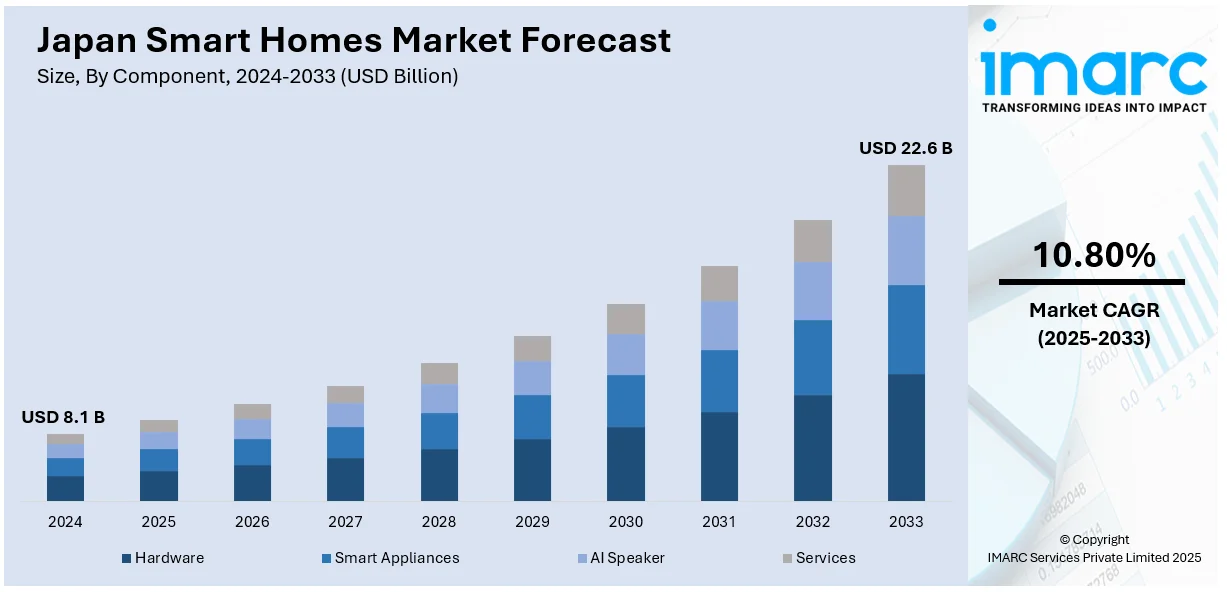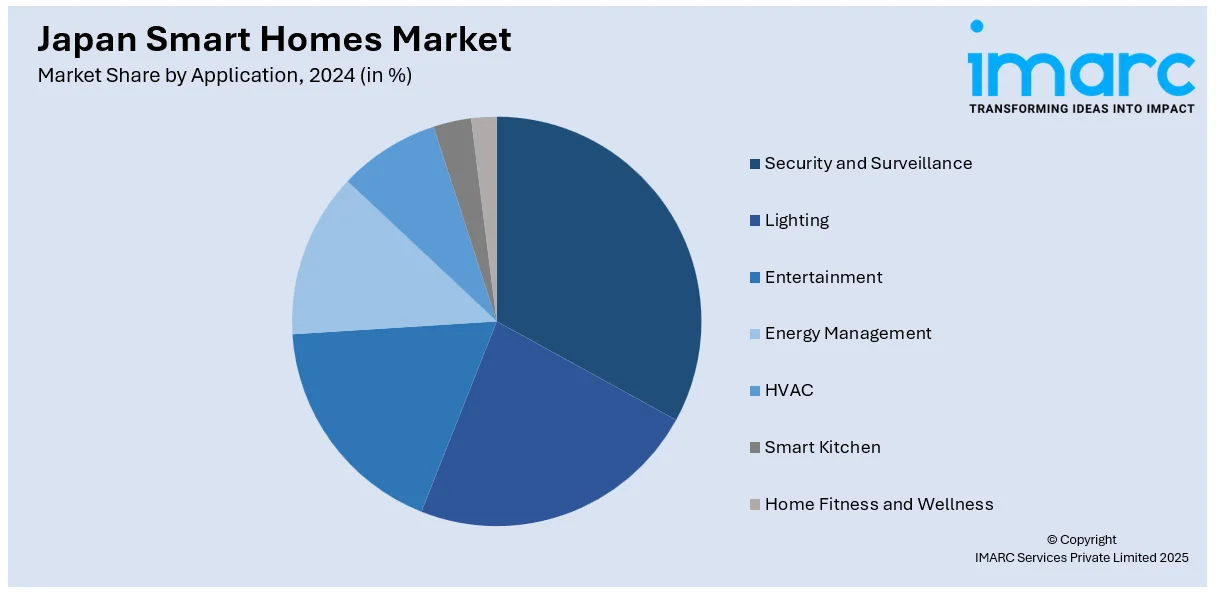
Japan Smart Homes Market Size, Share, Trends and Forecast by Component, Application, and Region, 2025-2033
Japan Smart Homes Market Overview:
The Japan smart homes market size reached USD 8.1 Billion in 2024. Looking forward, IMARC Group expects the market to reach USD 22.6 Billion by 2033, exhibiting a growth rate (CAGR) of 10.80% during 2025-2033. The market is experiencing significant growth, fueled by AI adoption, rising digital awareness, and demand for connected living. Moreover, technological innovation, urban convenience needs, and supportive government policies are accelerating smart home adoption across both new and existing residential setups.
|
Report Attribute
|
Key Statistics
|
|---|---|
|
Base Year
|
2024 |
|
Forecast Years
|
2025-2033
|
|
Historical Years
|
2019-2024
|
| Market Size in 2024 | USD 8.1 Billion |
| Market Forecast in 2033 | USD 22.6 Billion |
| Market Growth Rate 2025-2033 | 10.80% |
Japan Smart Homes Market Trends:
Rising Demand for Home Security
Rising concerns over burglary, intrusion, and overall personal safety have significantly boosted the demand for smart security solutions in Japan. Households are increasingly adopting smart surveillance cameras, motion sensors, smart locks, and door/window alarm systems that can be controlled remotely via smartphones. This shift reflects a broader preference for integrated and automated solutions that provide real-time alerts and control over residential safety. The Japan smart homes market growth is closely linked to this security-first mindset as consumers seek reliable, AI-enabled security technologies that also complement existing home automation setups. Growing urban density, rising disposable incomes, and the availability of affordable security devices are further supporting adoption. For instance, in September 2024, SwitchBot announced the launch of its Outdoor Security Camera 2K, featuring 2K resolution, AI-Powered Motion Detection, and two-way audio. It offers customizable detection zones, a 106dB alarm, and multiple power options, including solar charging. Designed for harsh weather, it’s IP65 waterproof and operates in extreme temperatures. Companies are innovating with facial recognition, voice commands, and cloud-based storage to enhance the functionality of smart home security systems. This segment is contributing positively to the Japan smart homes market outlook.

Integration with AI and IoT
AI and IoT technologies are at the heart of modern smart homes in Japan transforming how users interact with their living spaces. Voice-controlled smart speakers like Amazon Alexa, Google Assistant, and Line’s Clova are increasingly being used as central hubs to control lighting, appliances, security systems, and entertainment devices. This growing reliance on voice-controlled automation is now extending beyond stationary devices to mobile AI assistants. For instance, in May 2023, Japanese startup Preferred Robotics announced the launch of "Kachaka," a home-use AI robot that delivers items via voice commands. Designed to attach to a mobile table, it can navigate obstacles but not steps. It aims to reduce household chores, especially for those working remotely. These platforms allow for seamless automation users can manage multiple functions through simple voice commands or smartphone apps. AI algorithms enhance personalization by learning user preferences and adjusting settings accordingly, from ambient temperature to media choices. IoT connectivity ensures that devices can communicate with one another, enabling synchronized routines such as “good night” modes that turn off lights, lock doors, and adjust thermostats. As adoption of connected devices rises and consumers seek greater convenience AI and IoT integration will continue to increase Japan smart homes market share.
Japan Smart Homes Market Segmentation:
IMARC Group provides an analysis of the key trends in each segment of the market, along with forecasts at the country and regional levels for 2025-2033. Our report has categorized the market based on component and application.
Component Insights:
- Hardware
- Security
- Home Automation
- Home Entertainment
- Home Healthcare
- Smart Appliances
- AI Speaker
- Services
- Energy Consumption and Management Services
- Security Services
- Healthcare Services
- Entertainment Services
The report has provided a detailed breakup and analysis of the market based on the component. This includes hardware (security, home automation, home entertainment, and home healthcare), smart appliances, AI speaker, and services (energy consumption and management services, security services, healthcare services, and entertainment services).
Application Insights:

- Security and Surveillance
- Lighting
- Entertainment
- Energy Management
- HVAC
- Smart Kitchen
- Home Fitness and Wellness
A detailed breakup and analysis of the market based on the application have also been provided in the report. This includes security and surveillance, lighting, entertainment, energy management, HVAC, smart kitchen, and home fitness and wellness.
Regional Insights:
- Kanto Region
- Kansai/Kinki Region
- Central/Chubu Region
- Kyushu-Okinawa Region
- Tohoku Region
- Chugoku Region
- Hokkaido Region
- Shikoku Region
The report has also provided a comprehensive analysis of all the major regional markets, which include Kanto Region, Kansai/Kinki Region, Central/Chubu Region, Kyushu-Okinawa Region, Tohoku Region, Chugoku Region, Hokkaido Region, and Shikoku Region.
Competitive Landscape:
The market research report has also provided a comprehensive analysis of the competitive landscape. Competitive analysis such as market structure, key player positioning, top winning strategies, competitive dashboard, and company evaluation quadrant has been covered in the report. Also, detailed profiles of all major companies have been provided.
Japan Smart Homes Market News:
- In February 2024, Aqara announced the launch of its Amazon brand store in Japan, building on its previous success in the U.S. with seven smart home devices now available, including sensors and a camera. The expansion aims to enhance user experiences in Japan's smart home market, focusing on innovative solutions for various living scenarios.
- In May 2024, Qsee Technology announced its expansion into the Japanese market, aiming to introduce innovative smart home solutions and advanced security systems. In collaboration with retailer UNIQ STYLE, Qsee seeks to establish partnerships with local businesses, fostering growth while embracing Japan's rich culture to enhance product development and marketing strategies.
Japan Smart Homes Market Report Coverage:
| Report Features | Details |
|---|---|
| Base Year of the Analysis | 2024 |
| Historical Period | 2019-2024 |
| Forecast Period | 2025-2033 |
| Units | Billion USD |
| Scope of the Report | Exploration of Historical Trends and Market Outlook, Industry Catalysts and Challenges, Segment-Wise Historical and Future Market Assessment:
|
| Components Covered |
|
| Applications Covered | Security and Surveillance, Lighting, Entertainment, Energy Management, HVAC, Smart Kitchen, Home Fitness and Wellness |
| Regions Covered | Kanto Region, Kansai/Kinki Region, Central/Chubu Region, Kyushu-Okinawa Region, Tohoku Region, Chugoku Region, Hokkaido Region, Shikoku Region |
| Customization Scope | 10% Free Customization |
| Post-Sale Analyst Support | 10-12 Weeks |
| Delivery Format | PDF and Excel through Email (We can also provide the editable version of the report in PPT/Word format on special request) |
Key Questions Answered in This Report:
- How has the Japan smart homes market performed so far and how will it perform in the coming years?
- What is the breakup of the Japan smart homes market on the basis of component?
- What is the breakup of the Japan smart homes market on the basis of application?
- What is the breakup of the Japan smart homes market on the basis of region?
- What are the various stages in the value chain of the Japan smart homes market?
- What are the key driving factors and challenges in the Japan smart homes market?
- What is the structure of the Japan smart homes market and who are the key players?
- What is the degree of competition in the Japan smart homes market?
Key Benefits for Stakeholders:
- IMARC’s industry report offers a comprehensive quantitative analysis of various market segments, historical and current market trends, market forecasts, and dynamics of the Japan smart homes market from 2019-2033.
- The research report provides the latest information on the market drivers, challenges, and opportunities in the Japan smart homes market.
- Porter's five forces analysis assist stakeholders in assessing the impact of new entrants, competitive rivalry, supplier power, buyer power, and the threat of substitution. It helps stakeholders to analyze the level of competition within the Japan smart homes industry and its attractiveness.
- Competitive landscape allows stakeholders to understand their competitive environment and provides an insight into the current positions of key players in the market.
Need more help?
- Speak to our experienced analysts for insights on the current market scenarios.
- Include additional segments and countries to customize the report as per your requirement.
- Gain an unparalleled competitive advantage in your domain by understanding how to utilize the report and positively impacting your operations and revenue.
- For further assistance, please connect with our analysts.
 Request Customization
Request Customization
 Speak to an Analyst
Speak to an Analyst
 Request Brochure
Request Brochure
 Inquire Before Buying
Inquire Before Buying




.webp)




.webp)












